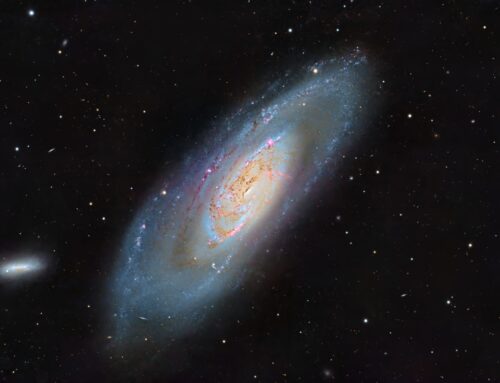The Cocoon Nebula and IC5146

Click image for full size version
February 1, 2015
IC5146 in Cepheus is a small and faint star cluster listed in the Index Catalogue (IC). The IC is a supplement to the New General Catalogue (the NGC) that lists deep sky objects discovered between 1888 and 1907. They tend to be very faint, which is why many of them weren’t discovered sooner. This star cluster is embedded in a glowing patch of gas known as the Cocoon Nebula, or Sh2-125. You may also notice there are relatively few stars around the nebula and to its lower right. This is a part of dark nebula B168, which is made up of dust that is blocking out the star light behind it. The star cluster IC5146 is quite young, with the bright star near its centre being only about 100,000 years old. The cluster and nebula are about 4,000 light years away, relatively close to us in cosmic terms.
There are some bonus objects in this image. Below the Cocoon is a lovely blue patch of reflection nebula, vdB147 (van den Burgh 147). There are also a pair of very faint galaxies in the top left of the image. PGC167593 (mag. 18.23) is just to the left of the brightest bluish star in the image. To its left is PGC167590 (mag. 18.50).
Tekkies:
SBIG STL-11000M camera, Baader LRGB filters, 10″ f/6.8 ASA astrograph, MI-250 mount. Guided with STL-11000’s external guider and a 500mm f.l. Lumicon guide scope. Focusing with FocusMax. Acquistion, guiding, calibration with Maxim-DL. All processing with PixInsight. Shot from my SkyShed in Guelph, Ontario. Ha was shot with nearly full moon. LRGB was shot with a first quarter moon. Transparency and seeing were average.
10x10m L, 8x5m R, 8x5m G, 8x5m B and 16x10m Ha (total 6hr20m)
Synthetic Luminance:
Creation and cleanup: The L,R,G,B and Ha masters were combined using the ImageIntegration tool (average, additive with scaling, noise evaluation, iterative K-sigma / biweight midvariance, no pixel rejection). DBE was applied to neutralize the background.
Deconvolution: A star mask was made to use as a local deringing support. A copy of the image was stretched to use as a range mask. Regularized Richardson-Lucy Deconvolution was applied (55 iterations, external PSF made using DynamicPSF tool with about 25 stars).
Stretching: HistogramTransformation was applied using autostretch settings from ScreenTransferFunction.
Ha, R, G and B masters were cropped to remove edge artifacts from stacking. The R, G and B channels were combined to make an RGB image. Ha and RGB were processed with DBE, ColourCalibration was applied, and the Ha and RGB were combined with the NB-RGB script. HistogramTransformation was applied using autostretch settings from ScreenTransferFunction.
The luminance was extracted from the HaRGB image, processed and then added back into the HaRGB image as follows:
1. Extract luminance from the HaRGB image.
2. Apply LinearFit using the SynthL channel as a reference.
3. Use ChannelCombination in the Lab mode to replace the luminance of the HaRGB with the fitted luminance from step 2.
4. Use LRGBCombine to apply SynthL to the HaRGB image.
Additional Processing
HDR Processing: HDRMultiscaleTransform was applied with 6 and 4 pixel scales, with a mask being used to protect bright stars.
Noise Reduction and Re-Stretch: TGVDenoise was applied in Lab mode with 300 iterations with a range mask used to protect nebula and stars. This was followed by a HistogramTransformation to raise the black point (but with no clipping). A range mask was made to protect background and stars and LocalHistogramEqualization was applied to boost contrast in the nebula.
Dark Structures: DarkStructureEnhance script was applied (0.1 strength).
Star Reduction and Colour Adjustment: Morphological transformation (3×3, 6 iterations, strength 0.15) was applied to medium and small stars using a star mask to protect background, bright stars and nebula. Luminance was extracted from the image and LinearMultiscaleTransform was applied to extract the first 4 wavelet layers (no residual). This image was used as a mask when applying ColourSaturation to boost colour in the star cores.
Final Steps: A contrast adjustment was applied.
Image scale is about 1.1 arcsec per pixel for this camera / telescope combination.






[…] This object is sometimes referred to as the Little Cocoon Nebula, in reference to the much more famous Cocoon Nebula. […]
Great quality in the details. Very well balanced. The photo is nice to see a sign of a good processing.